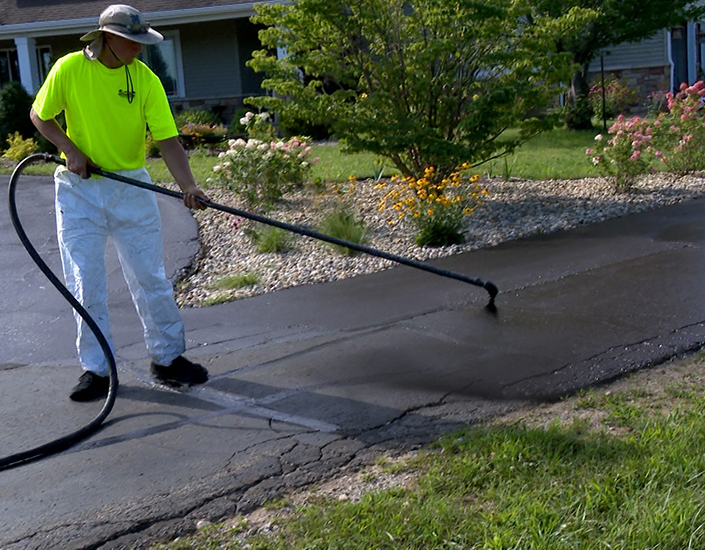Warm Mix Asphalt: A Lasting Remedy for Sidewalk
Warm Mix Asphalt (HMA) has actually emerged as a leading sustainable option for pavement solutions, offering a myriad of environmental advantages and cutting-edge modern technologies. As the demand for environment-friendly construction methods grows, discovering the nuances of HMA's sustainability can give beneficial insights right into the future of sidewalk services.
Environmental Benefits of Warm Mix Asphalt

In Addition, Warm Mix Asphalt helps to minimize metropolitan warmth island effects. Its dark shade absorbs sunlight, decreasing the amount of warm reflected back right into the atmosphere compared to lighter-colored pavements. This can reduce ambient temperature levels in city areas, decreasing the demand for air conditioning and ultimately minimizing energy consumption.
Additionally, Hot Mix Asphalt adds to improved stormwater administration. Its porous nature permits water to penetrate the sidewalk and charge groundwater materials, reducing overflow and the threat of flooding. These ecological advantages make Warm Mix Asphalt a sustainable choice for paving freeways and roads.
Energy Effectiveness in HMA Production
Is energy efficiency a vital variable in the production of Warm Mix Asphalt (HMA)? Energy plays a considerable duty in the production of HMA, influencing both cost and environmental sustainability. One essential element of power performance in HMA production is the use of cozy mix asphalt (WMA) innovations.
Additionally, improvements in plant modern technologies have led to more energy-efficient HMA production procedures. By enhancing power usage in HMA production, the industry can minimize its carbon impact while keeping top quality sidewalk products.
Recyclability of Warm Mix Asphalt
The recyclability of Hot Mix Asphalt (HMA) is a pivotal aspect of its sustainability and long-lasting ecological impact. HMA is among one of the most recycled materials in the USA, with over 100 million bunches of recovered asphalt sidewalk (RAP) being recycled every year in brand-new pavement building and construction. Recycling HMA uses a number of ecological benefits, such as lowering the need for virgin products, reducing power intake throughout production, and reducing the quantity of waste sent out to garbage dumps.
The procedure of recycling HMA includes milling the existing pavement, click here for more squashing it into smaller sized items, and blending it with new aggregate and asphalt binder to produce a recycled mix. Overall, the recyclability of HMA plays a significant function in advertising sustainable methods within the pavement industry.

Long-Term Efficiency of HMA
Asphalt pavements demonstrate durability and strength over an extensive duration, mirroring the long-lasting performance of Warm Mix Asphalt (HMA) In addition, innovations in HMA modern technology, such as the usage of polymer-modified binders and warm mix asphalt, have actually further improved the their website longevity and long life of HMA sidewalks. By prioritizing high quality building and construction and upkeep techniques, HMA continues to show itself as a lasting and cost-efficient solution for resilient sidewalk facilities.

HMA: Resilience and Sustainability
Showing both longevity and sustainability, Warm Mix Asphalt (HMA) has actually become a keystone in the building of lasting pavement facilities - hot mix asphalt. HMA's sturdiness stems from its capacity to hold up against heavy lots, extreme weather, and high web traffic quantities, making it a dependable choice for roads, freeways, and airport terminal runways. The structure of HMA, which normally includes accumulations, binder, and filler, plays an important role in enhancing its durability and resistance to tear and wear
Furthermore, HMA's sustainability lies in its recyclability and energy-efficient manufacturing procedure. The capability to reuse redeemed asphalt sidewalk (RAP) in brand-new HMA blends reduces the need link for virgin materials and lessens the environmental effect of pavement construction and maintenance. Additionally, the power effectiveness of producing HMA exists in its lower mixing temperatures compared to other pavement materials, leading to decreased energy intake and greenhouse gas exhausts.
Verdict
In final thought, hot mix asphalt (HMA) uses a lasting remedy for sidewalk with its eco friendly features. HMA's recyclability, power efficiency in manufacturing, and long-lasting longevity make it a green option for road construction.
HMA is one of the most recycled materials in the United States, with over 100 million lots of recovered asphalt sidewalk (RAP) being recycled each year in new sidewalk construction.The procedure of recycling HMA entails milling the existing pavement, squashing it right into smaller items, and mixing it with new accumulation and asphalt binder to develop a recycled mix.Asphalt pavements demonstrate longevity and durability over an extensive period, mirroring the long-term efficiency of Warm Mix Asphalt (HMA) In addition, developments in HMA technology, such as the use of polymer-modified binders and cozy mix asphalt, have even more enhanced the sturdiness and longevity of HMA pavements. The ability to recycle reclaimed asphalt pavement (RAP) in new HMA mixes decreases the need for virgin products and minimizes the environmental effect of pavement building and construction and maintenance.